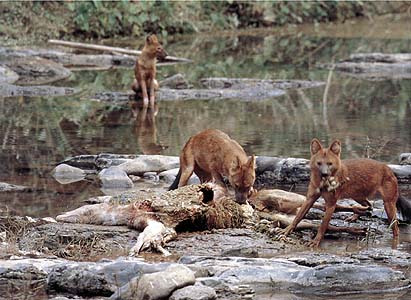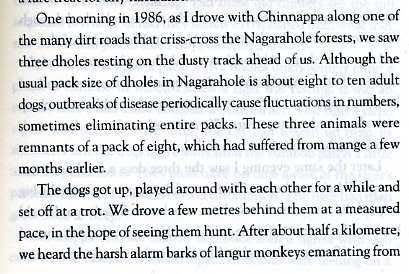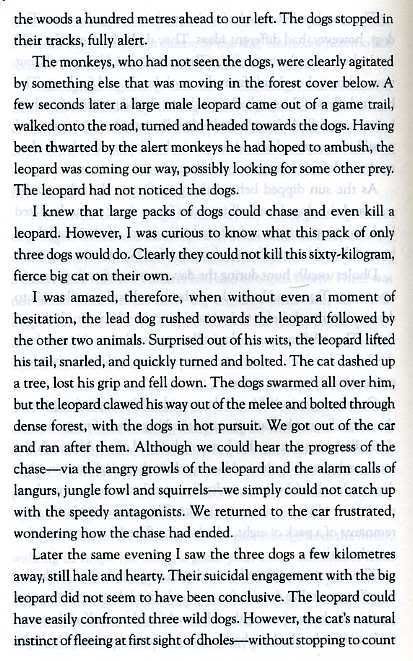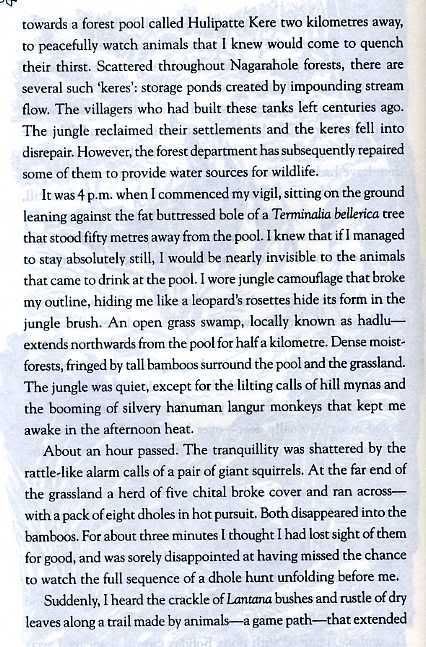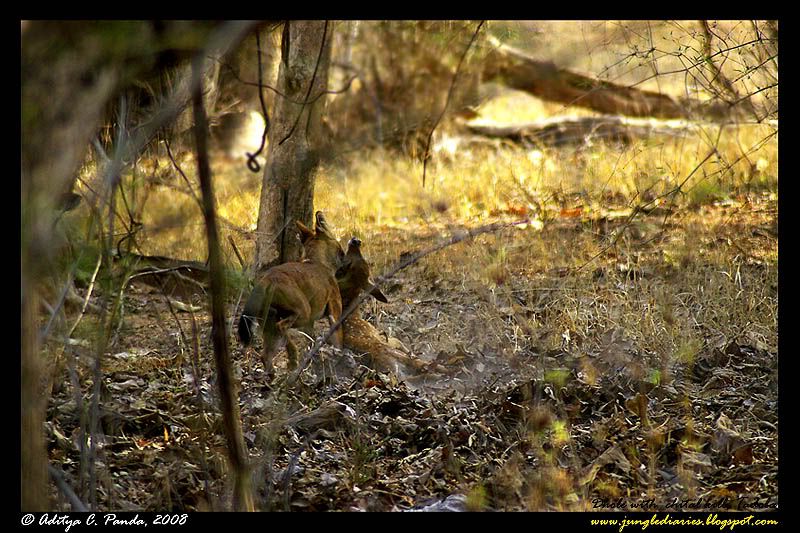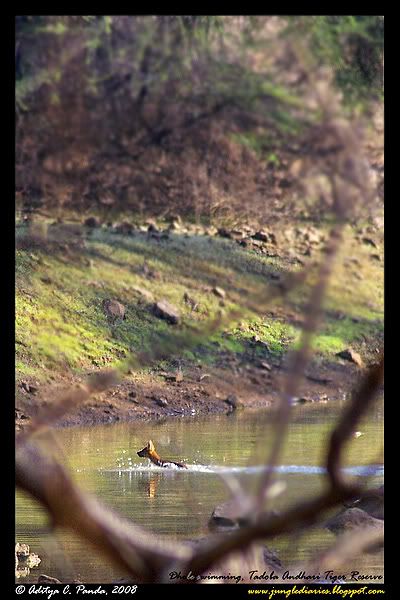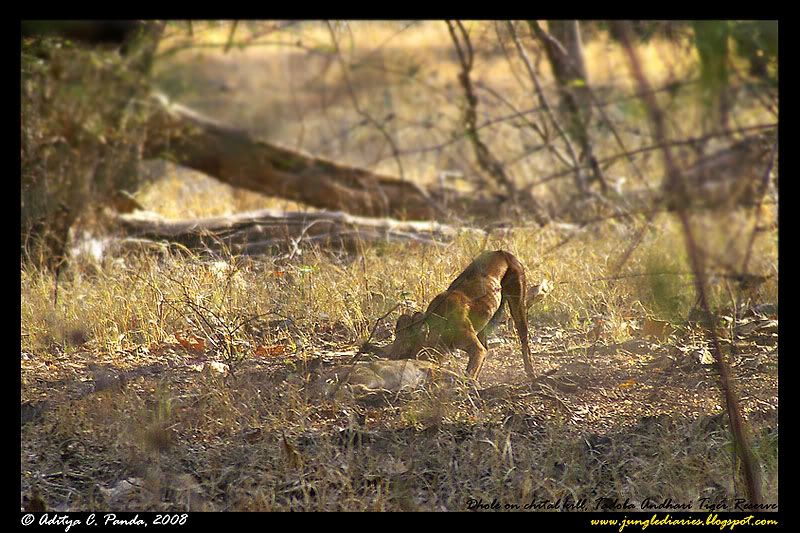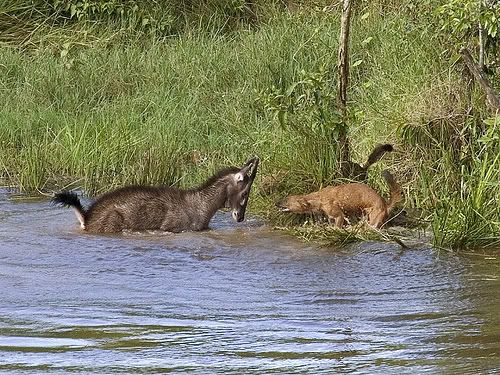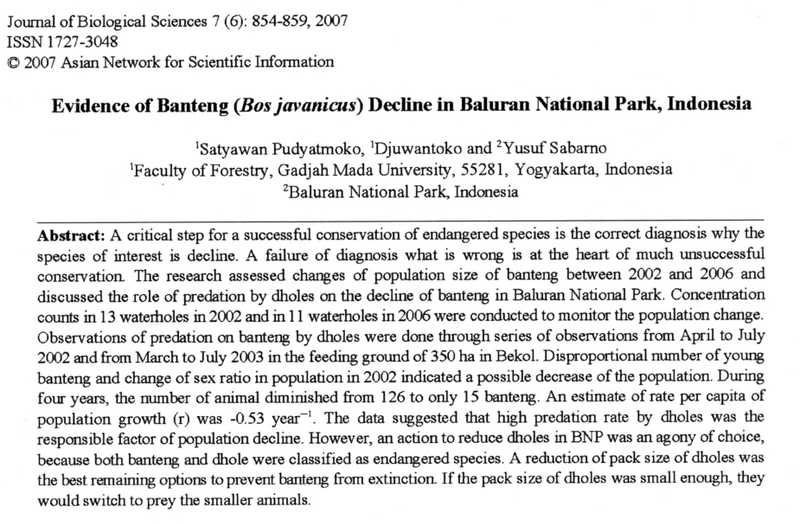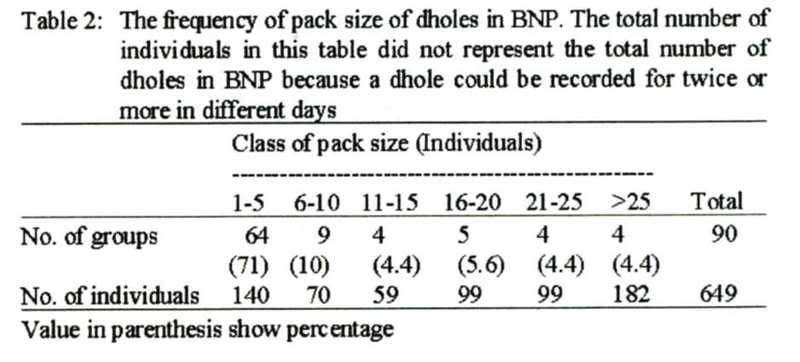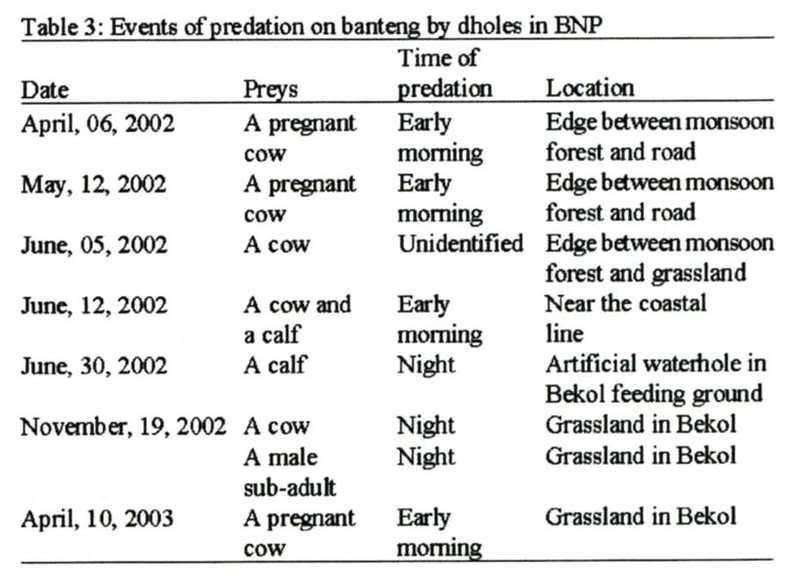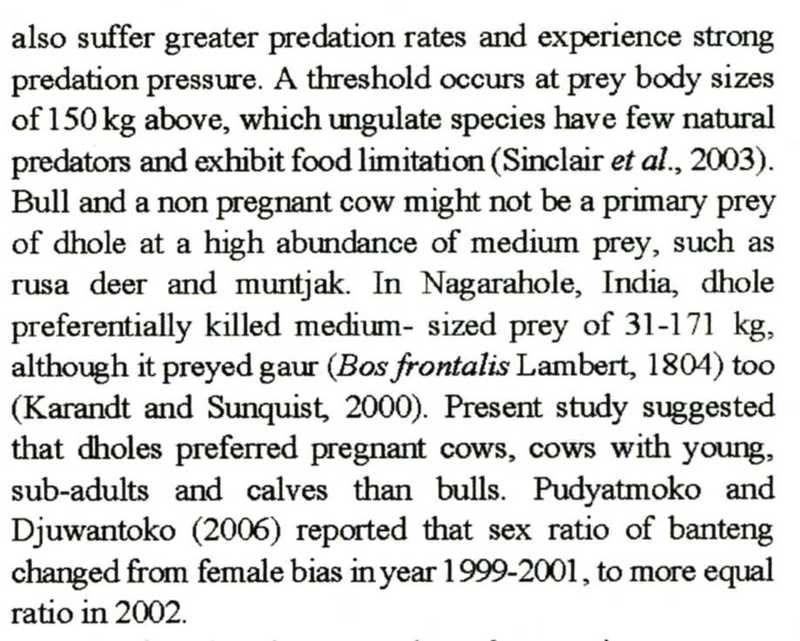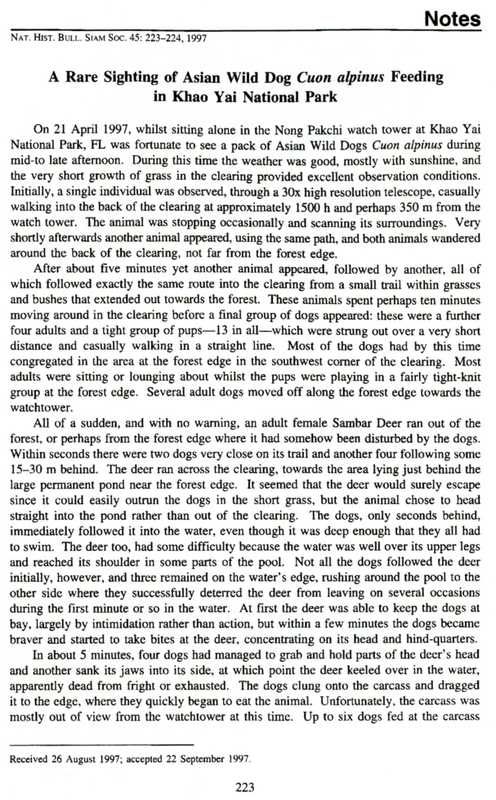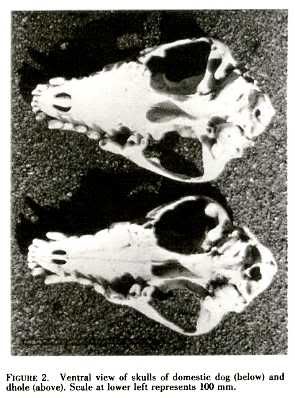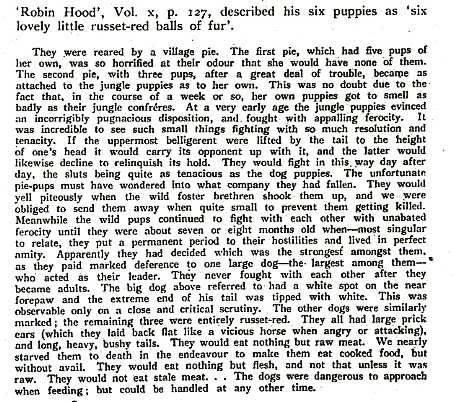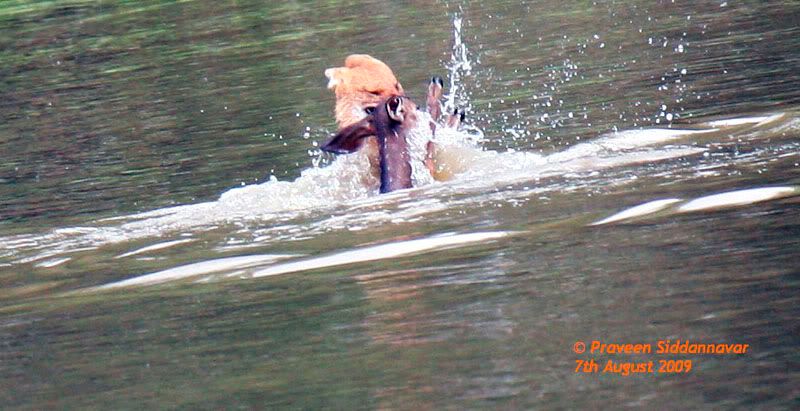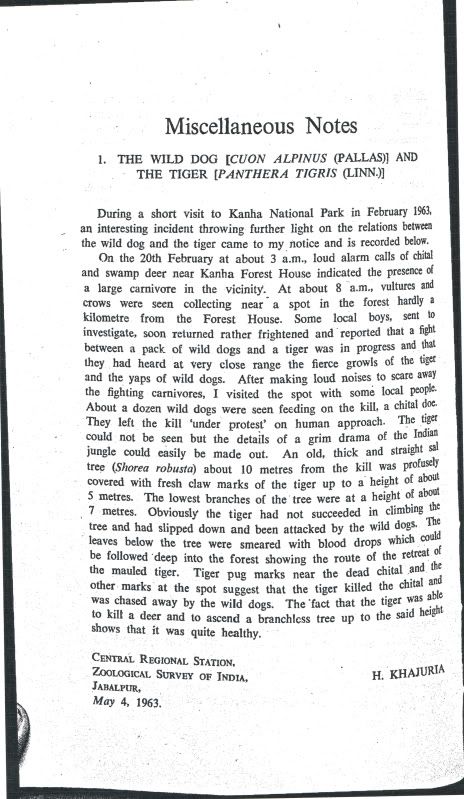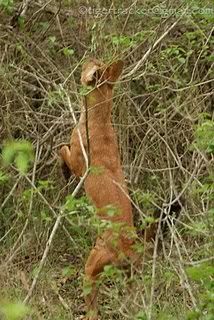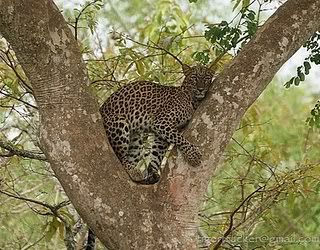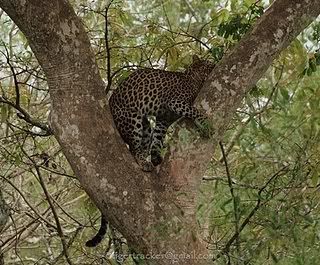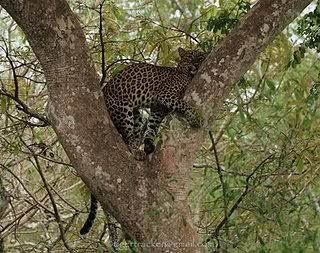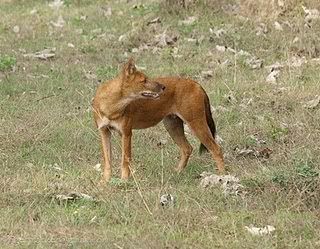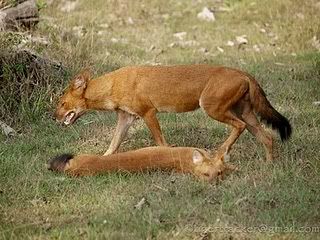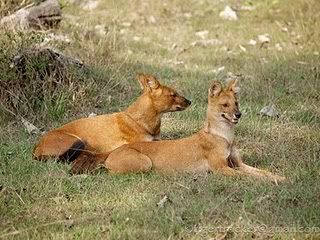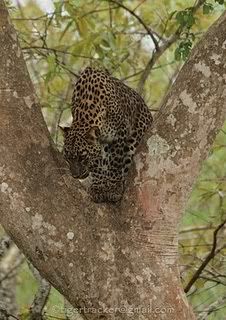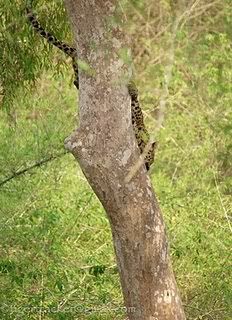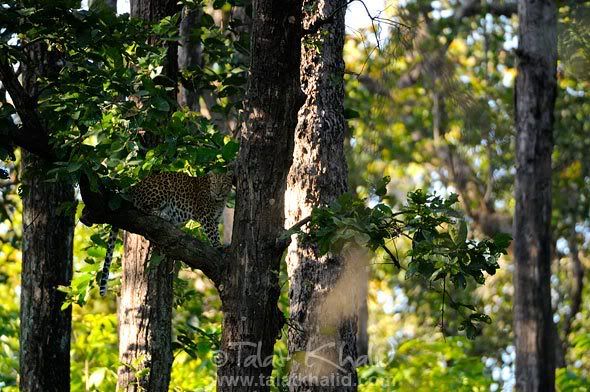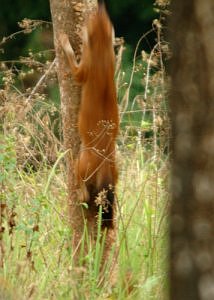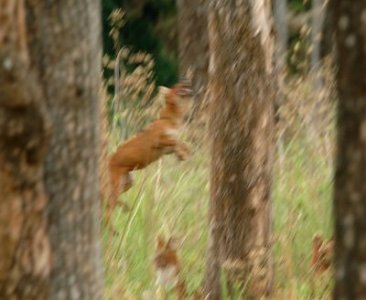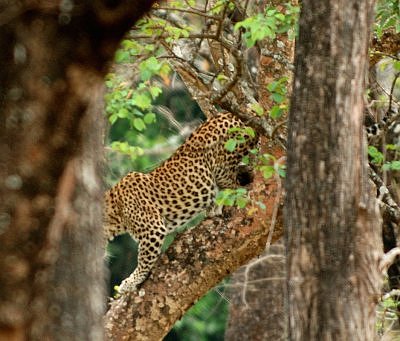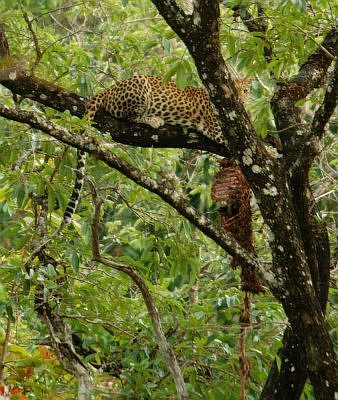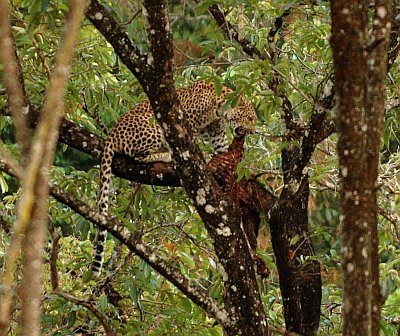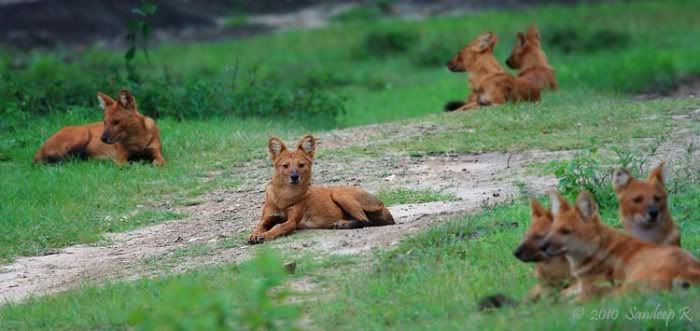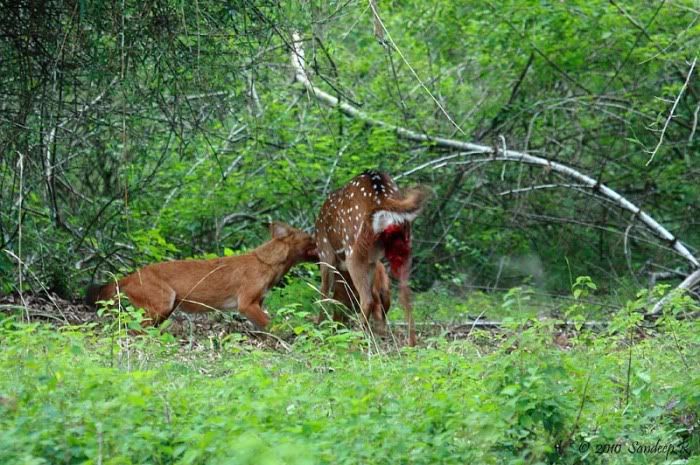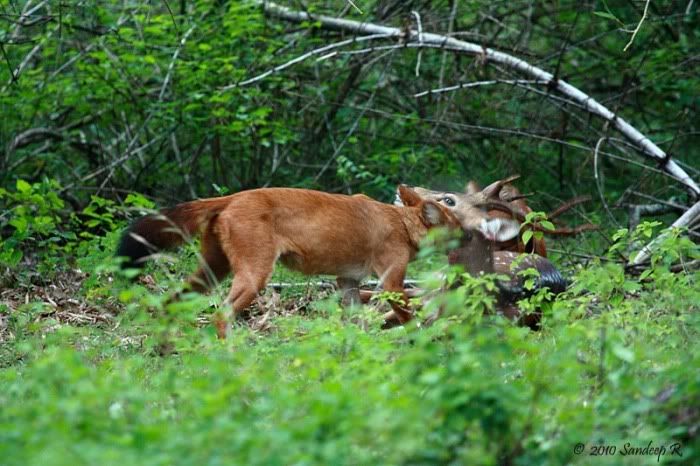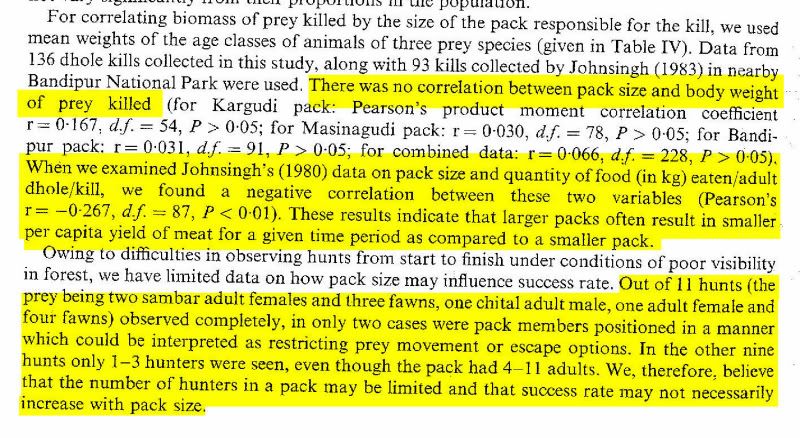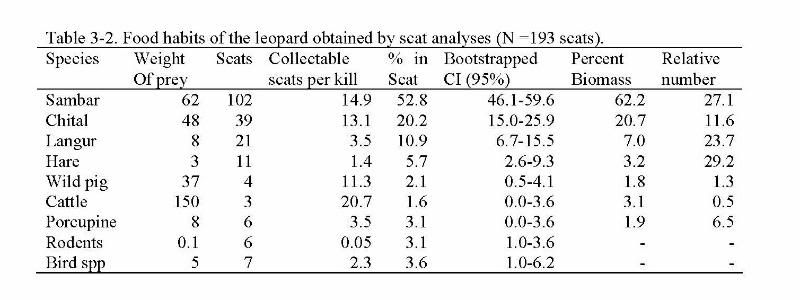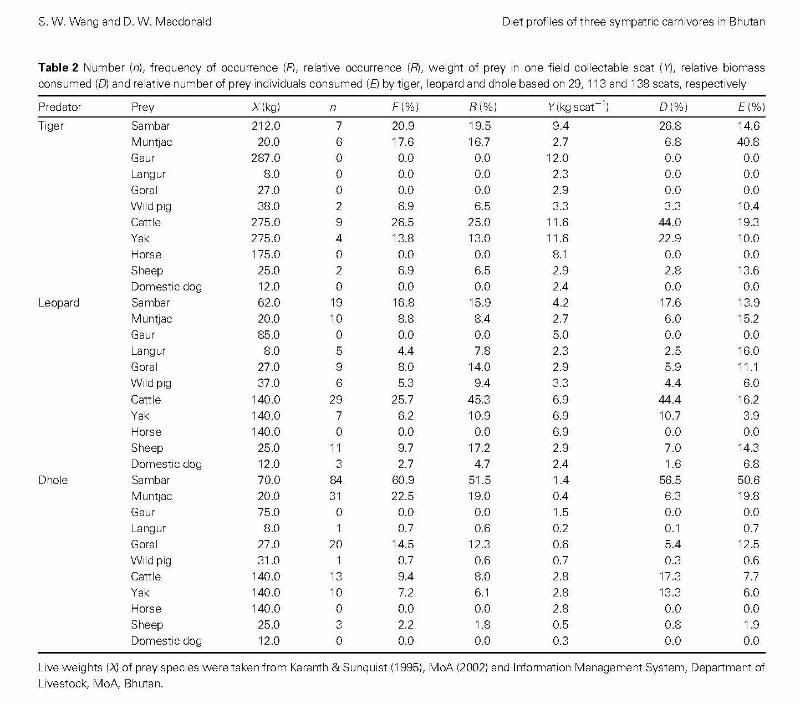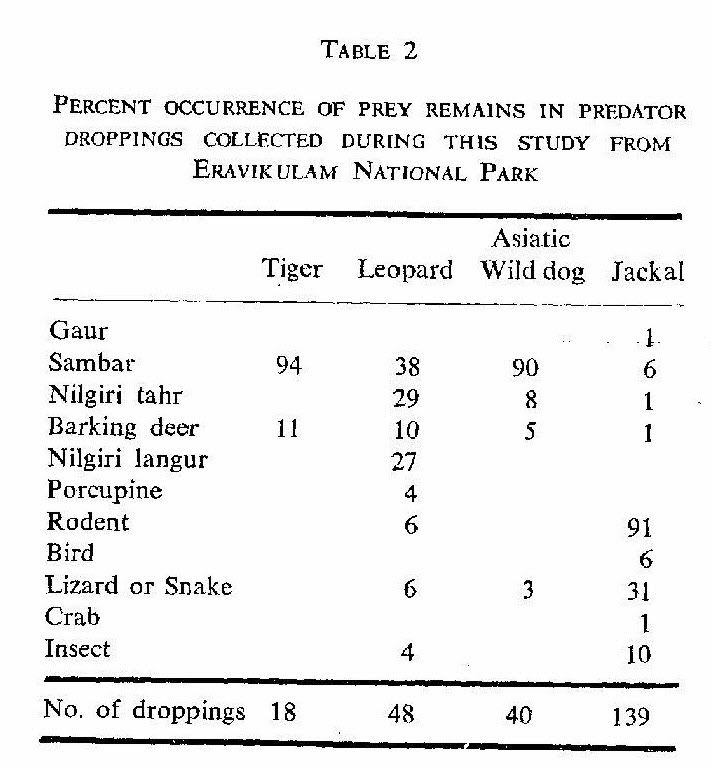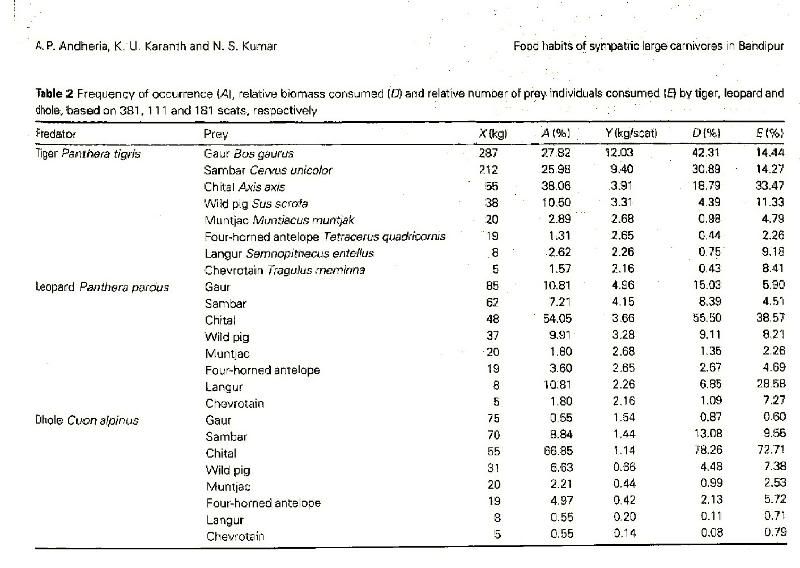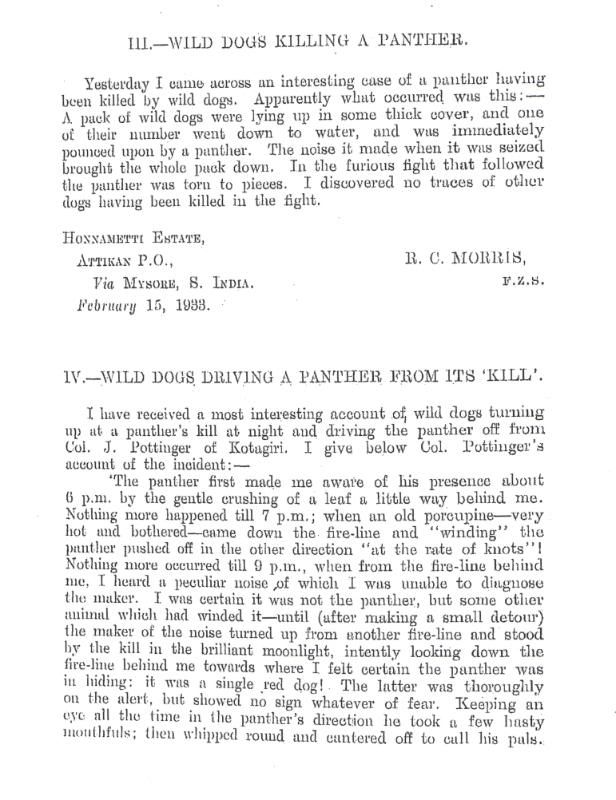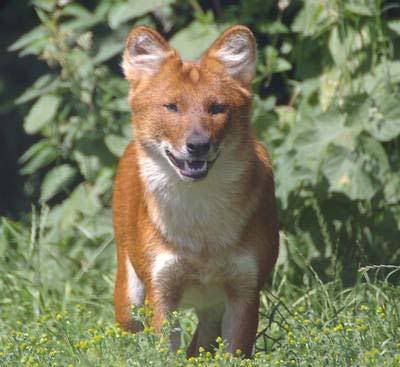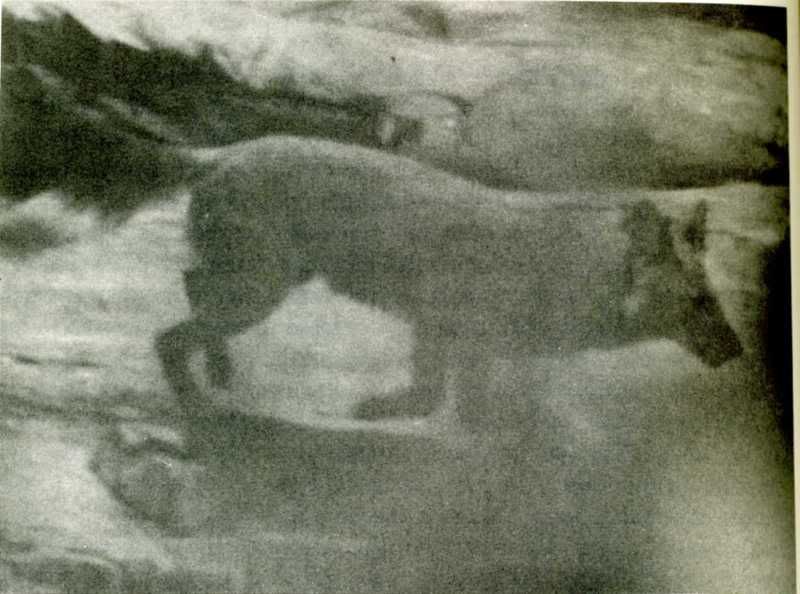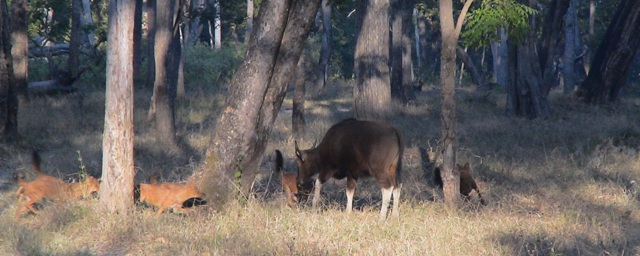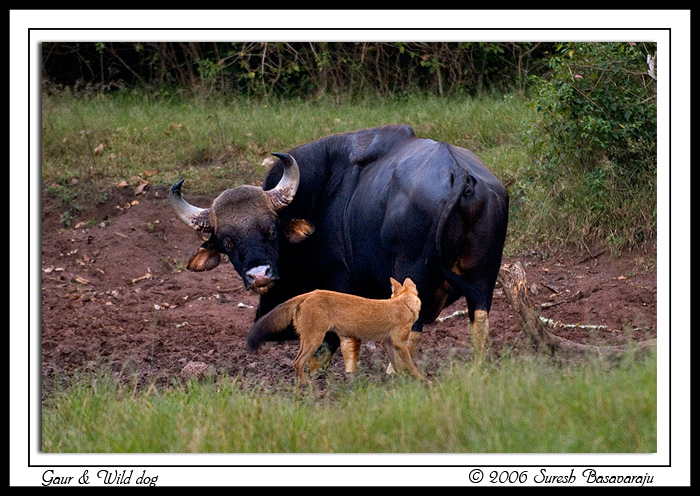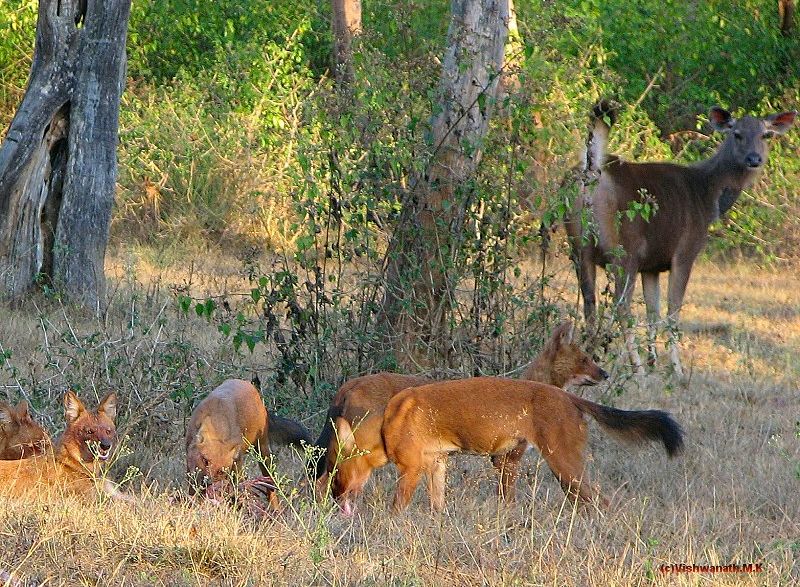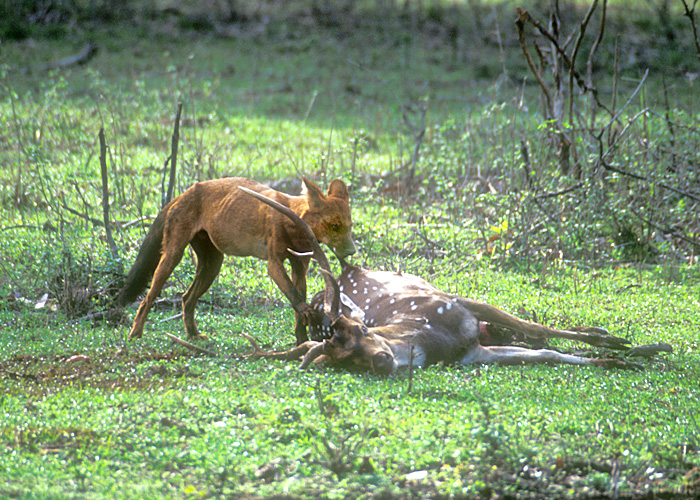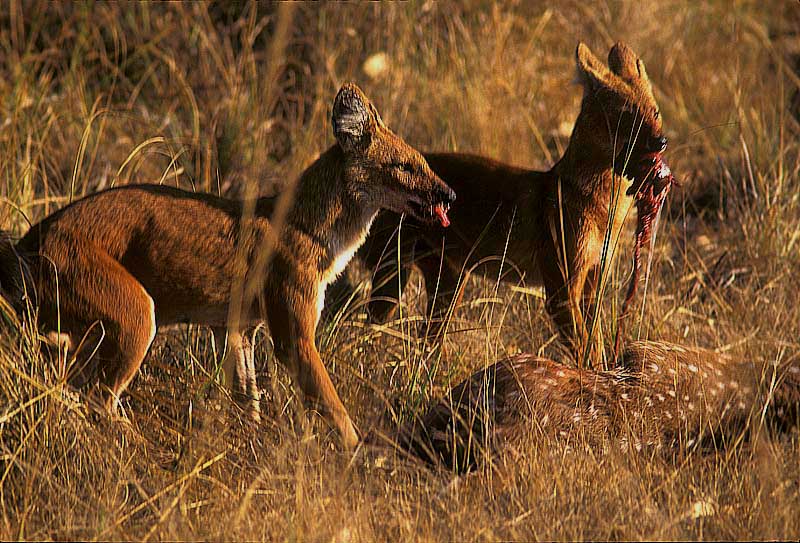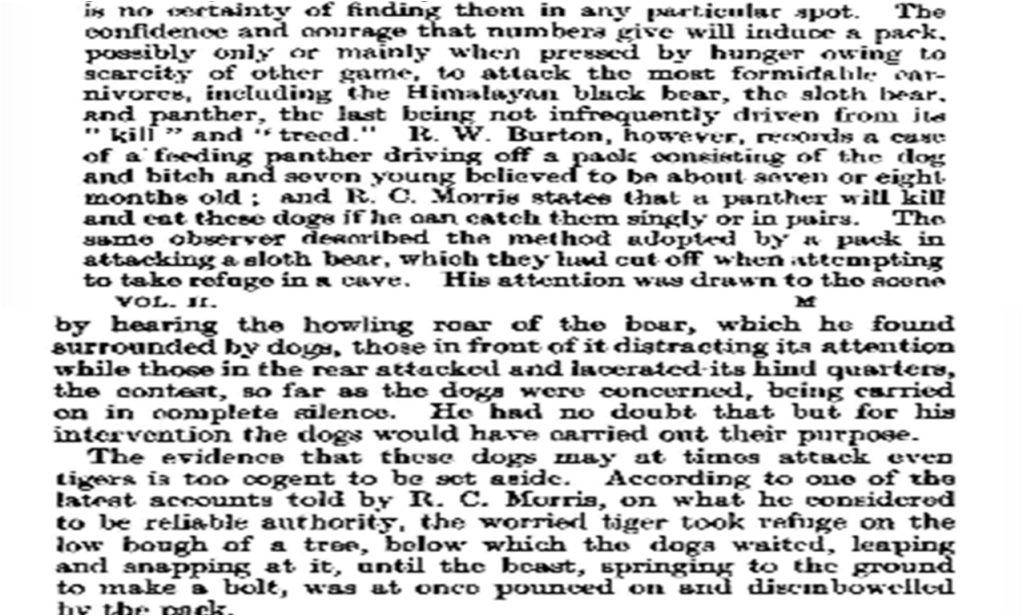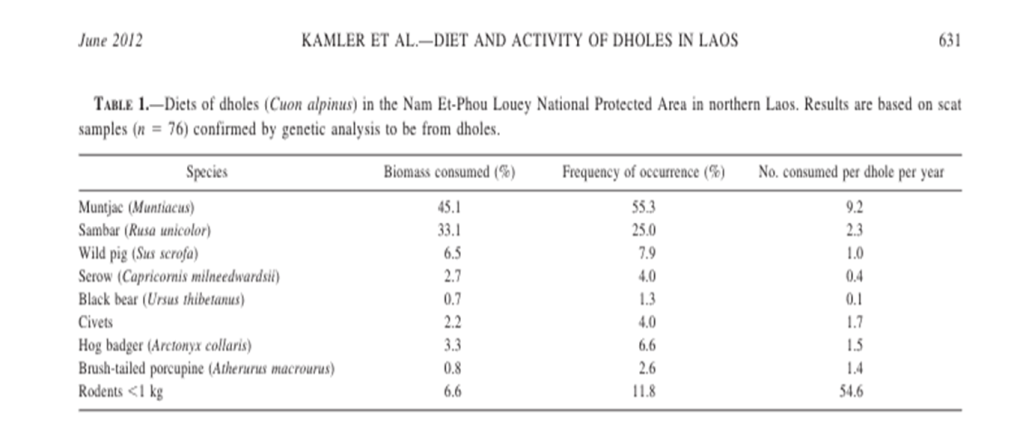Post by LeopJag on May 29, 2013 8:03:28 GMT 5
Dhole (Asiatic Wild Dog) - Cuon alpinus
The dhole (Cuon alpinus) is a species of canid native to South and Southeast Asia. It is the only extant member of the genus Cuon, which differs from Canis by the reduced number of molars and greater number of teats. The dholes are classed as endangered by the IUCN, due to ongoing habitat loss, depletion of its prey base, competition from other predators, persecution and possibly diseases from domestic and feral dogs. The dhole is a highly social animal, living in large clans which occasionally split up into small packs to hunt.[3] It primarily preys on medium-sized ungulates, which it hunts by tiring them out in long chases, and kills by disemboweling them. Unlike most social canids (but similar to African wild dogs), dholes let their pups eat first at a kill. Though fearful of humans, dhole packs are bold enough to attack large and dangerous animals such as wild boar, water buffalo, and even tigers. Prey animals in India include chital, sambar, muntjac, mouse deer, swamp deer, wild boar, gaur, water buffalo, banteng, cattle, nilgai, goats, Indian hares, Himalayan field rats and langurs. They are smaller than African wild dogs. Weight ranges from 10 to 25 kg (22 to 55 lb), with males averaging about 4.5 kg (9.9 lb) heavier. This dog is 88 to 113 cm (35 to 44 in) long from the snout to the base of the tail, with the tail averaging 45 cm (18 in) in length. Shoulder height is 42 to 55 cm (17 to 22 in).
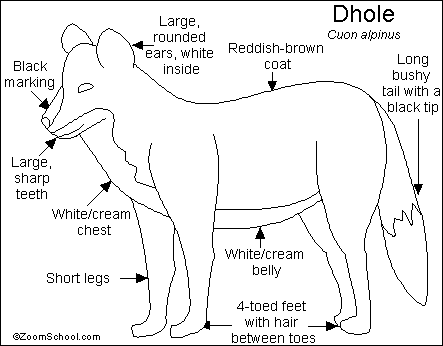
The dhole or Asiatic Wild Dog (Cuon alpinus) is about the size of a border collie (12-18 kg), but looks quite different. The coat is usually a rusty red colour, but varies regionally from sandy yellow to dark grey. See our dhole map page for details of regional colour variation (frame-compliant browsers only). Usually it has a black bushy tail and white patches on its chest, paws and belly. Its ears are rounded, and its hooded amber eyes portray an intelligent nature.
Within the canid family the dhole is something of an enigma. It doesn't fit neatly into any of the sub-families (i.e. the foxes or wolf-like dogs) and is classified in a genus of its own - Cuon. Among its unusual features is a strange whistle call which it uses to re-assemble the pack when animals become separated in dense forest. The dhole also has more teets than most other dogs and has a shorter jaw with one less molar on each side of its lower jaw.
Social Behaviour
The dhole is a highly social and cooperative animal, living in organised packs of around 10 individuals. Groups often contain more males than females, with usually just one breeding female. Occasionally, large groups of over 40 dogs have been seen, possibly arising from the temporary fusion of neighbouring packs.
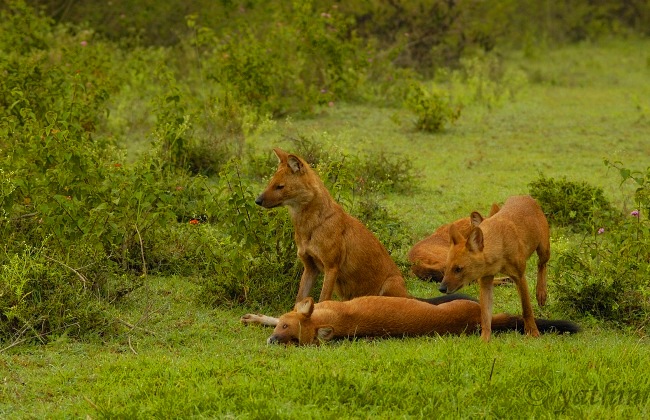
Together with the grey wolf, African hunting dog and Amazonian bush dog, the dhole is one of the few dogs that regularly hunts in packs. This requires intelligence, co-ordination, and sometimes courage! In India, one of the dhole's favourite prey is the medium-sized Axis deer. On occasions, however, it will tackle even larger prey like the banteng (a large bovid), and highly aggressive prey like the wild boar. With such dangerous quarry, the dogs can literally risk their lives to secure the food they need to survive. Communal hunting is particularly important during the breeding season when pack members return to the den to regurgitate food for the mother and pups. Sometimes, however, dholes prefer to hunt individually or in pairs, focusing on smaller prey such as hares.
Habitat and Geographical Range
Habitat: usually forest (dry deciduous,moist deciduous, tropical rain forest), also meadows & steppe
Geographical range: Latitude: 10 deg. South to 55 deg. North; Longitude: 70 deg. East to 170 deg. East

The dhole normally lives in forest habitats, but can also eke out an existence in the open steppes of Kashmir and Siberia. As the Latin name, Cuon alpinus suggests, the dhole is often found in hilly or mountainous regions. The dhole's historical range reflects this great adaptability, extending from India to Russia, and down through China to Malaysia and Indonesia (Java being the southern limit). In recent decades, however, there has been massive habitat loss within this region. Today, very little is known about the dhole's distribution, but restricted surveys indicate serious decline and fragmentation of the former range. The best remaining populations are probably to be found in central and southern India, but even their stability is in question. The urgent need for more information on the dhole's present distribution has been highlighted in the latest IUCN Action Plan for Canids. In response to this plan, DCP have designed a sighting form and questionnaire survey and are compiling information on the dhole's status and distribution. Armed with such knowledge we will be in a much better position to mobilise direct conservation action.
Diet:
Almost exclusively meat: usually deer, but also wild boar, hares, depending on availability.
The dhole eats wild berries, insects, and lizards. Packs of dholes feast on mammals ranging from rodents to deer. Some of the dhole's favorites include wild pigs, hares, wild goats, sheep, and occasionally a monkey. Unlike many other "dogs," the dhole seldom kills by biting the throat. Larger mammals are attacked from the rear, while smaller ones are caught by any part of the bodies. The smaller mammals are killed by a swift blow to the head; the larger mammals are immediately disembowled. Dholes compete for the food, not by fighting, but by how fast they can eat. An adult dhole can eat up to 4kg (8.8lbs) of meat in one hour. Two to three dholes can kill a 50kg (110 lb) deer in less than two minutes, and they begin to feed on it before it is dead. The larger prey rarely die from the attack itself, but from blood loss and shock as their intestines, heart, liver, and eyes are feasted upon.

Reproduction
Gestation period: ca. 63 days
litter size: 1-12 pups
Breeding season: November - April (most births in December in India)
Longevity: At least 15 years in captivity
Sexual maturity: c. 1 year old
Activity pattern: diurnal/crepuscular occasionally nocturnal

Interesting Facts : Did you know?...
Sources :
www.cuon.net/dholes/
animaldiversity.ummz.umich.edu/site/accounts/information/Cuon_alpinus.html
*
While I certainly think some of the accounts above were embellished and exaggerated, I suspect there is some truth to them. During that time, both dholes and tigers lived at densities far greater than today. Thus, encounters were far more frequent.
Also, I believe that dhole packs would have been larger back then due to better supplies of game.
I once emailed a dhole researcher about the Connell and Anderson accounts and he believed they were true (likely not every detail) and thought they could have involved the packs defending a den from tigers.
However, I could see why some may have some skepticism about these accounts.
Anyway, the only modern research I have on this topic is the following reference:
Venkataraman, A. (1995). Do dholes (Cuon alpinus) live in packs in response to competition with or predation by large cats. Current Science.11: 934-936.
In this paper, they reference the Connell account and several similar older accounts from the Journal of Bombay Natural History. Evidently, at least IMHO, it seems they view these as factual events. Here is a summary:
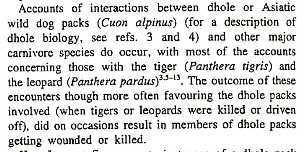
The paper also tries to explain group-living in dholes as a possible adaption for living with leopards and tigers. They found that dholes (which may live in smaller packs now due to habitat degredation) were more aggressive towards leopards than tigers. They theorize that this is because tigers are more dangerous, but also because leopards prey more on dholes (thus there is more reward for attacking leopards).
Here is the paper's summary:
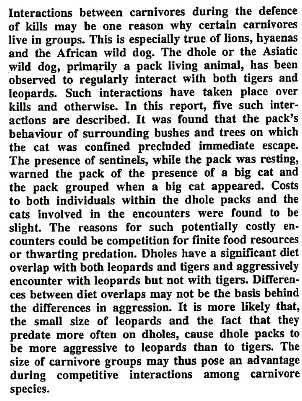
Here are their observations of dhole-big cat encounters:
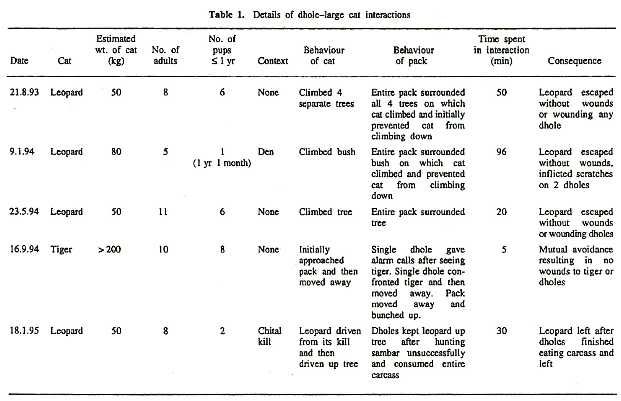
Here is a comparison of the three predators' diets:

Here are some observations from Michael W. Fox's book "The Whistling Hunters", which was about his field study of dholes in India during the 1970s:
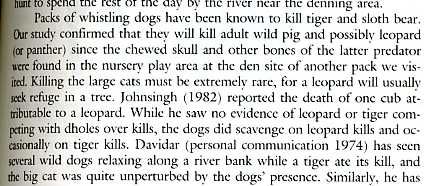

This study documents dhole predation on adult female banteng and their calves. Adult female banteng can weigh 1,400 lbs.
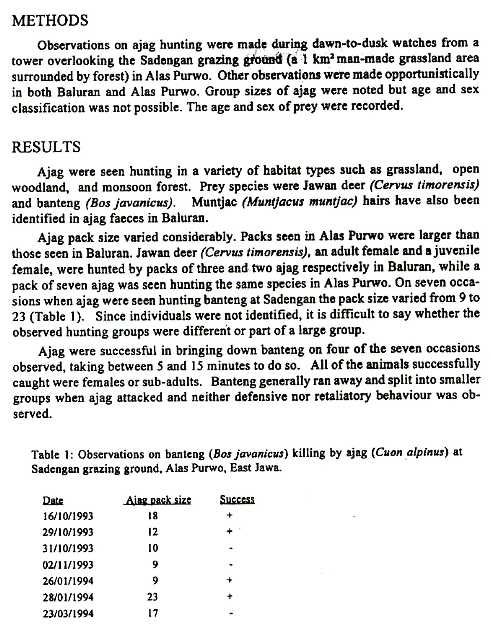
The following is from Lon Grassman's study of dholes in Thailand. The reference is as follows:
Grassman, L. I., Jr., M. E. Tewes, N. J. Silvy, and K. Kreetiyutanont. 2005. Spatial ecology and diet of the dhole Cuon alpinus (Canidae, Carnivora) in north central Thailand. Mammalia. 69: 11-20.

Note: 3 dholes killed a sambar cow and attacked her eyes:
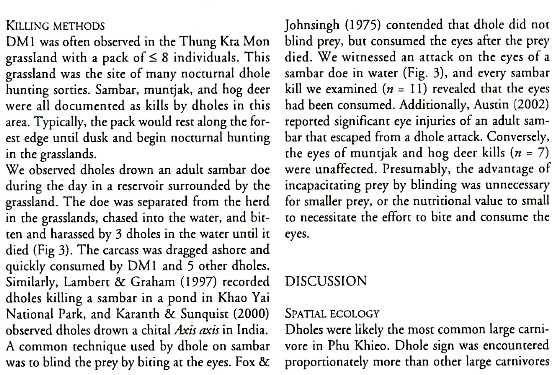
Photo of Sambar Cow with Injured Eye Being Attacked:
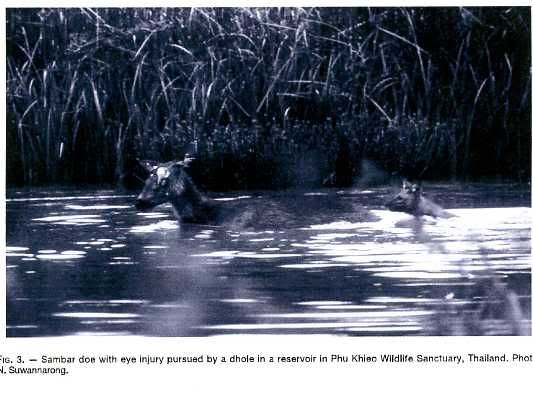
Video of Two Dholes Hunting a Chital Stag
www.youtube.com/watch?v=RKkTw6ev3oc
Photos of Dholes Attacking Sambar in India

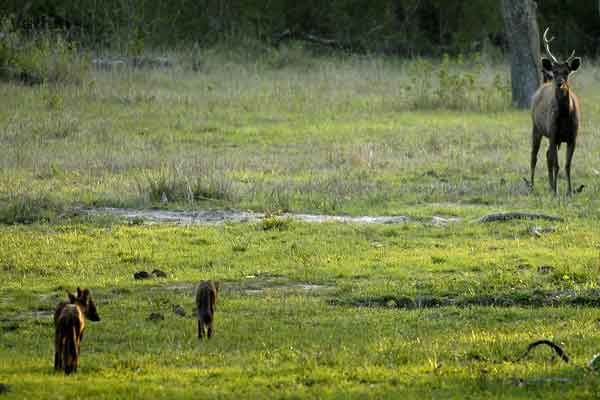
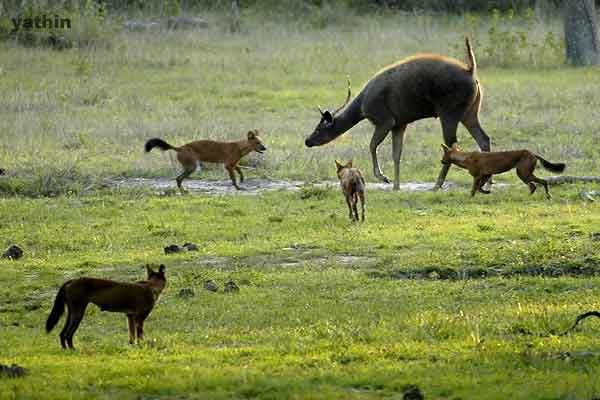

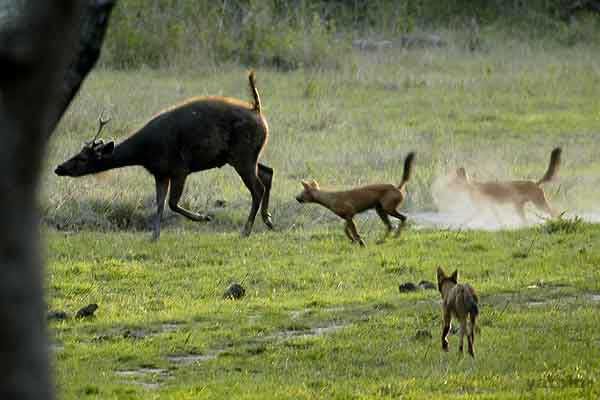
From Maze:
attack sambar

hi reddhole,how many dholes cam kill an adult guar or buffalo?
*
Not sure; I've never seen any accounts of dholes killing either gaur or buffalo. I imagine it would be a similar number as those killing adult female banteng (9-23 dholes above). However, the number of these that were pups/immature animals isn't clear, so perhaps not that many is needed.
That being said, more normal prey for dholes are chital and sambar.
Read more: carnivora.proboards.com/index.cgi?action=display&board=canine&thread=931&page=1#ixzz1itUO2a2H
Video of dholes taking down a chital stag (you need to click the quicktime option to view it):
www.arkive.org/species/GES/mammal....movietype=qtMed
Videos of dholes feeding:
www.arkive.org/species/GES/mammal....movietype=qtMed
www.arkive.org/species/GES/mammal....movietype=qtMed
Read more: carnivora.proboards.com/index.cgi?action=display&board=canine&thread=931&page=1#ixzz1itUTyJ91
The dhole (Cuon alpinus) is a species of canid native to South and Southeast Asia. It is the only extant member of the genus Cuon, which differs from Canis by the reduced number of molars and greater number of teats. The dholes are classed as endangered by the IUCN, due to ongoing habitat loss, depletion of its prey base, competition from other predators, persecution and possibly diseases from domestic and feral dogs. The dhole is a highly social animal, living in large clans which occasionally split up into small packs to hunt.[3] It primarily preys on medium-sized ungulates, which it hunts by tiring them out in long chases, and kills by disemboweling them. Unlike most social canids (but similar to African wild dogs), dholes let their pups eat first at a kill. Though fearful of humans, dhole packs are bold enough to attack large and dangerous animals such as wild boar, water buffalo, and even tigers. Prey animals in India include chital, sambar, muntjac, mouse deer, swamp deer, wild boar, gaur, water buffalo, banteng, cattle, nilgai, goats, Indian hares, Himalayan field rats and langurs. They are smaller than African wild dogs. Weight ranges from 10 to 25 kg (22 to 55 lb), with males averaging about 4.5 kg (9.9 lb) heavier. This dog is 88 to 113 cm (35 to 44 in) long from the snout to the base of the tail, with the tail averaging 45 cm (18 in) in length. Shoulder height is 42 to 55 cm (17 to 22 in).
The dhole or Asiatic Wild Dog (Cuon alpinus) is about the size of a border collie (12-18 kg), but looks quite different. The coat is usually a rusty red colour, but varies regionally from sandy yellow to dark grey. See our dhole map page for details of regional colour variation (frame-compliant browsers only). Usually it has a black bushy tail and white patches on its chest, paws and belly. Its ears are rounded, and its hooded amber eyes portray an intelligent nature.
Within the canid family the dhole is something of an enigma. It doesn't fit neatly into any of the sub-families (i.e. the foxes or wolf-like dogs) and is classified in a genus of its own - Cuon. Among its unusual features is a strange whistle call which it uses to re-assemble the pack when animals become separated in dense forest. The dhole also has more teets than most other dogs and has a shorter jaw with one less molar on each side of its lower jaw.
Social Behaviour
The dhole is a highly social and cooperative animal, living in organised packs of around 10 individuals. Groups often contain more males than females, with usually just one breeding female. Occasionally, large groups of over 40 dogs have been seen, possibly arising from the temporary fusion of neighbouring packs.

Together with the grey wolf, African hunting dog and Amazonian bush dog, the dhole is one of the few dogs that regularly hunts in packs. This requires intelligence, co-ordination, and sometimes courage! In India, one of the dhole's favourite prey is the medium-sized Axis deer. On occasions, however, it will tackle even larger prey like the banteng (a large bovid), and highly aggressive prey like the wild boar. With such dangerous quarry, the dogs can literally risk their lives to secure the food they need to survive. Communal hunting is particularly important during the breeding season when pack members return to the den to regurgitate food for the mother and pups. Sometimes, however, dholes prefer to hunt individually or in pairs, focusing on smaller prey such as hares.
Habitat and Geographical Range
Habitat: usually forest (dry deciduous,moist deciduous, tropical rain forest), also meadows & steppe
Geographical range: Latitude: 10 deg. South to 55 deg. North; Longitude: 70 deg. East to 170 deg. East

The dhole normally lives in forest habitats, but can also eke out an existence in the open steppes of Kashmir and Siberia. As the Latin name, Cuon alpinus suggests, the dhole is often found in hilly or mountainous regions. The dhole's historical range reflects this great adaptability, extending from India to Russia, and down through China to Malaysia and Indonesia (Java being the southern limit). In recent decades, however, there has been massive habitat loss within this region. Today, very little is known about the dhole's distribution, but restricted surveys indicate serious decline and fragmentation of the former range. The best remaining populations are probably to be found in central and southern India, but even their stability is in question. The urgent need for more information on the dhole's present distribution has been highlighted in the latest IUCN Action Plan for Canids. In response to this plan, DCP have designed a sighting form and questionnaire survey and are compiling information on the dhole's status and distribution. Armed with such knowledge we will be in a much better position to mobilise direct conservation action.
Diet:
Almost exclusively meat: usually deer, but also wild boar, hares, depending on availability.
The dhole eats wild berries, insects, and lizards. Packs of dholes feast on mammals ranging from rodents to deer. Some of the dhole's favorites include wild pigs, hares, wild goats, sheep, and occasionally a monkey. Unlike many other "dogs," the dhole seldom kills by biting the throat. Larger mammals are attacked from the rear, while smaller ones are caught by any part of the bodies. The smaller mammals are killed by a swift blow to the head; the larger mammals are immediately disembowled. Dholes compete for the food, not by fighting, but by how fast they can eat. An adult dhole can eat up to 4kg (8.8lbs) of meat in one hour. Two to three dholes can kill a 50kg (110 lb) deer in less than two minutes, and they begin to feed on it before it is dead. The larger prey rarely die from the attack itself, but from blood loss and shock as their intestines, heart, liver, and eyes are feasted upon.

Reproduction
Gestation period: ca. 63 days
litter size: 1-12 pups
Breeding season: November - April (most births in December in India)
Longevity: At least 15 years in captivity
Sexual maturity: c. 1 year old
Activity pattern: diurnal/crepuscular occasionally nocturnal

Interesting Facts : Did you know?...
[*]The dhole has some extraordinary vocal calls - it can whistle, scream, mew, and even cluck like a chicken.
[*]It's been a distinct species for several million years.
[*]It can urinate while doing a handstand on its front two legs
[*]Sometimes it forms temporary packs of over 40 animals.
[*]It breeds communally with most pack members helping to feed or guard the pups.
[*]When hunting as a pack it can subdue prey over 10 times its own body weight, and can even fend off a tiger!
[*]It exploits a variety of habitats from tropical rain forest and dry-deciduous jungle, to cold alpine forest and open plains.
[*]It has amazing jumping powers and can reach a vertical height of at least 2.3 metres (7.5 ft).
[*]Its dental formula is unique among the dog family.
[*]It is a capable swimmer and often drives its prey into water.
Sources :
www.cuon.net/dholes/
animaldiversity.ummz.umich.edu/site/accounts/information/Cuon_alpinus.html
*
taipan said:
Reddhole, what do you know/think about Tiger v Dholes?While I certainly think some of the accounts above were embellished and exaggerated, I suspect there is some truth to them. During that time, both dholes and tigers lived at densities far greater than today. Thus, encounters were far more frequent.
Also, I believe that dhole packs would have been larger back then due to better supplies of game.
I once emailed a dhole researcher about the Connell and Anderson accounts and he believed they were true (likely not every detail) and thought they could have involved the packs defending a den from tigers.
However, I could see why some may have some skepticism about these accounts.
Anyway, the only modern research I have on this topic is the following reference:
Venkataraman, A. (1995). Do dholes (Cuon alpinus) live in packs in response to competition with or predation by large cats. Current Science.11: 934-936.
In this paper, they reference the Connell account and several similar older accounts from the Journal of Bombay Natural History. Evidently, at least IMHO, it seems they view these as factual events. Here is a summary:

The paper also tries to explain group-living in dholes as a possible adaption for living with leopards and tigers. They found that dholes (which may live in smaller packs now due to habitat degredation) were more aggressive towards leopards than tigers. They theorize that this is because tigers are more dangerous, but also because leopards prey more on dholes (thus there is more reward for attacking leopards).
Here is the paper's summary:

Here are their observations of dhole-big cat encounters:

Here is a comparison of the three predators' diets:

Here are some observations from Michael W. Fox's book "The Whistling Hunters", which was about his field study of dholes in India during the 1970s:


This study documents dhole predation on adult female banteng and their calves. Adult female banteng can weigh 1,400 lbs.

The following is from Lon Grassman's study of dholes in Thailand. The reference is as follows:
Grassman, L. I., Jr., M. E. Tewes, N. J. Silvy, and K. Kreetiyutanont. 2005. Spatial ecology and diet of the dhole Cuon alpinus (Canidae, Carnivora) in north central Thailand. Mammalia. 69: 11-20.

Note: 3 dholes killed a sambar cow and attacked her eyes:

Photo of Sambar Cow with Injured Eye Being Attacked:

Video of Two Dholes Hunting a Chital Stag
www.youtube.com/watch?v=RKkTw6ev3oc
Photos of Dholes Attacking Sambar in India





From Maze:
attack sambar

hi reddhole,how many dholes cam kill an adult guar or buffalo?
*
Not sure; I've never seen any accounts of dholes killing either gaur or buffalo. I imagine it would be a similar number as those killing adult female banteng (9-23 dholes above). However, the number of these that were pups/immature animals isn't clear, so perhaps not that many is needed.
That being said, more normal prey for dholes are chital and sambar.
Read more: carnivora.proboards.com/index.cgi?action=display&board=canine&thread=931&page=1#ixzz1itUO2a2H
Video of dholes taking down a chital stag (you need to click the quicktime option to view it):
www.arkive.org/species/GES/mammal....movietype=qtMed
Videos of dholes feeding:
www.arkive.org/species/GES/mammal....movietype=qtMed
www.arkive.org/species/GES/mammal....movietype=qtMed
Read more: carnivora.proboards.com/index.cgi?action=display&board=canine&thread=931&page=1#ixzz1itUTyJ91


